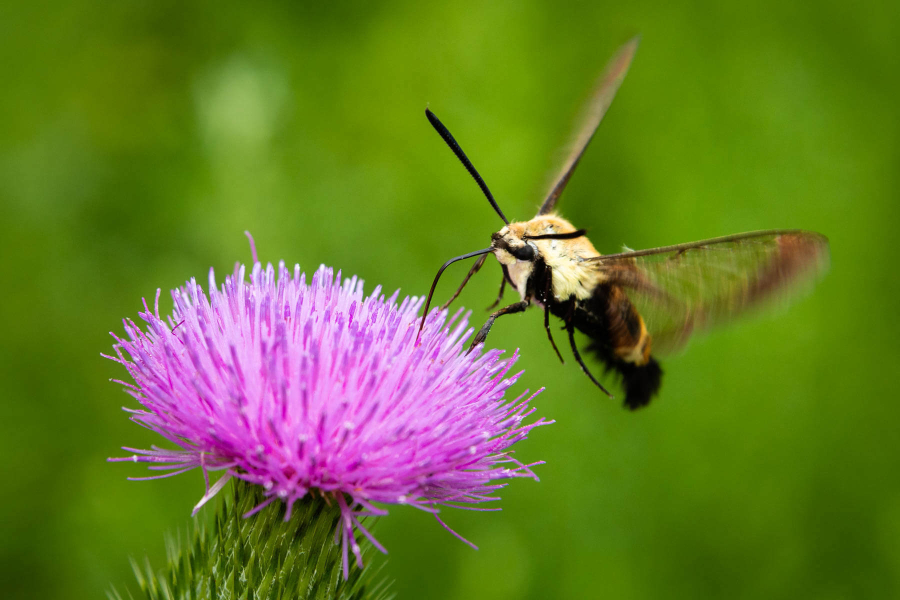Clearing up confusion around the snowberry clearwing

If you’ve ever seen a snowberry clearwing zoom over your garden or sip nectar from a flower, you might be left wondering if what you saw was a bird, a bee or something in between.
Surprisingly, it’s neither; it’s a moth. In fact, the snowberry clearwing is also known as the hummingbird moth or flying lobster moth. It takes its name from the snowberry plant, a deciduous shrub in the honeysuckle family. As a caterpillar, the clearwing is especially fond of the snowberry, snacking on its leaves and using it as a host when constructing its cocoon.
The snowberry clearwing is a day-flying moth and a member of the sphinx moth family. Like a sphinx, the clearwing blurs the line between a few different species. Its shimmering, scaly wings look as if they should belong to a butterfly, while its broad, furry, yellow thorax is almost identical to that of a bumblebee. Meanwhile, the clearwing’s jittery, hovering flight pattern seems to invoke that of a hummingbird.
Much like a hummingbird, the snowberry clearwing does not land on a flower when enjoying its nectar. Instead, it will hover above the blossom, beating its wings at a rate of up to 70 beats per second while remaining completely stationary in the air, emitting a low humming sound. When feeding from a flower, the snowberry clearwing uses a proboscis: a straw-like tongue that unfurls from underneath its chin, allowing it to reach nectar from deep inside a flower where other insects cannot reach.
The snowberry clearwing is found throughout the Chesapeake Bay watershed and is especially common in the summertime when flowers are in full bloom and emit a delicious scent that the clearwing finds irresistible. Zooming from flower to flower in a blink of an eye, the clearwing is a highly efficient pollinator and plays an important part in keeping our gardens healthy.
If you want to attract snowberry clearwing to your backyard, consider planting bright, sweet-smelling plants such as native honeysuckle or butterflyweed.

Comments
Northeast Tennessee here had one or two last year this year have seen as many as 6 at one time. They are loving my zinnias!
Thanks for the article. I believe I saw a hummingbird moth feeding on the flowers in my central Kentucky yard. Is this unusual?
Larry, great questions! Snowberry clearwings (or Hummingbird Moth) only live a few months and some live only a few weeks. They tend to be resident species though some migrate.
How long of a life span ? Do they migrate?
I have a pic of one in NW Kansas
Hi Dylan: great article! We live on the Bay in Machipongo, VA, and have been changing the grass yard to flower beds. After 5 years we now have a pair of Snowberry Clearwing hummingbird moths enjoying the nectar from the bee balm and butterfly bushes, I’m hoping they will lay eggs on the honeysuckle vine so we have more next year. It’s been a lot of hard work to add native flowering plants from the grass only landscape we came to, but it seems to be paying off, American Goldfinchs arrived this year too.
Thank you!
Your comment has been received. Before it can be published, the comment will be reviewed by our team to ensure it adheres with our rules of engagement.
Back to recent stories